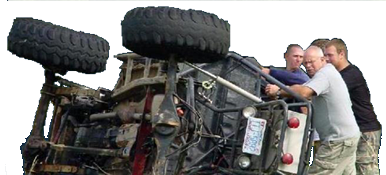Copied from another board but applies to All Toyotas in some ways........ But mostly to the pre Taco.
Thermostat Problem
Question:
“Why does my engine temp go all the way up to the red before it comes back down to the middle of the gauge after I start it up in the morning. It only does this when the engine is cold and once it warms up it seems to operate normally. Could it be as simple as a stuck thermostat?â€
Answer:
(From Roger Brown’s Web Site)
“What happens on the 22R and 22RE engine, when the coolant goes through the heater core it gets cooled off enough that when it gets dumped back in on top of the t-stat it shuts it. Therefore the temperature in the engine continues to go up. The t-stat that I have mentioned has two valves in it, one at the regular temp. and one smaller on at a cooler temp. If the cool water shuts the big one, the smaller one stays open. All this happens because of the lack of a by-pass hose, which on other systems, keeps hot coolant running on the t-stat.â€
You can get the two-stage thermostat mentioned above from your local Toyota Dealer.
Part Number: #90916-03070
Cone Washers
Cone washers are the washers that are behind the nuts holding on Toyota wheel hubs and steering arms.
Cone washers are a pain in the ass. Anyone from the dry areas of the southwest will tell you that a good smack on the stud will loosen them up. If you are in or near the Midwest... forget that.
Using one or all of the following (most likely all) you should be able to get them off.
Soak it in something like PB Blaster
Put the nut on the stud and hit the nut with a brass drift and hammer
Use an air chisel - being careful of studs etc
Wedge a screwdriver or similar into the small slit of the washer
Beat the hub housing like a red-headed step child with a hard plastic or rubber mallet
If worst comes to worst (and if you are in the Midwest it probably will) then you can try hitting the hub housing itself with a small sledge hammer. At this point you will want to hit it with one anyway. The trick is not hitting hard enough to damage it.
Bleeding Brakes
This is the proper way to bleed your brakes to avoid spongy brakes, etc...
1. Drivers side rear
2. Passenger side rear
3. Passenger side front
4. Drivers side front
5. LSPV (Load sensing proportioning valve)
Adding Power to the 22re
"Ok ready, first pull off the efi fuse for a couple of seconds, then reinstall it. Grab some Autolite #65 plugs, and side gap them at .048. Set the valve clearance to .011 cold. Install the factory carbed thermostat {Pappy: it's a 180* vs. 190*). Adjust the AFM 3 teeth rich (under 5000 a.s.l.). Start the motor, let idle till you reach operating temp. Set the timing at 16* "not short circuted," {Pappy: about the same as 8* shorted} then take it for a putt, re check the timing, and enjoy. Leave the airbox alone, for it's not a cause of starvation on a stocker, and don't worry about the muffler for now. If you're going to modify the exhaust, start with a header, and 2.5" headpipe."
A follow-up from later that day:
"... you pull the EFI fuse to start the ECU's regathering of fuel mixture readings, because you are altering them via the AFM. The #65's are a hotter plug, and will in this case create a more efficient burn. You WILL NOT detonate when the timing is set 16* NOT SHORT CIRCUTED, because the end reading when short circuted will be 8* advanced. The afm adjustment enrichens the motor aproximately 3cc. This is necessary due to the timing advance, which requires a proper mixture."
I found the AFM 3 teeth to be too rich for my high desert home (driveway is 5200 ft) and have backed it down to 1 tooth rich.

